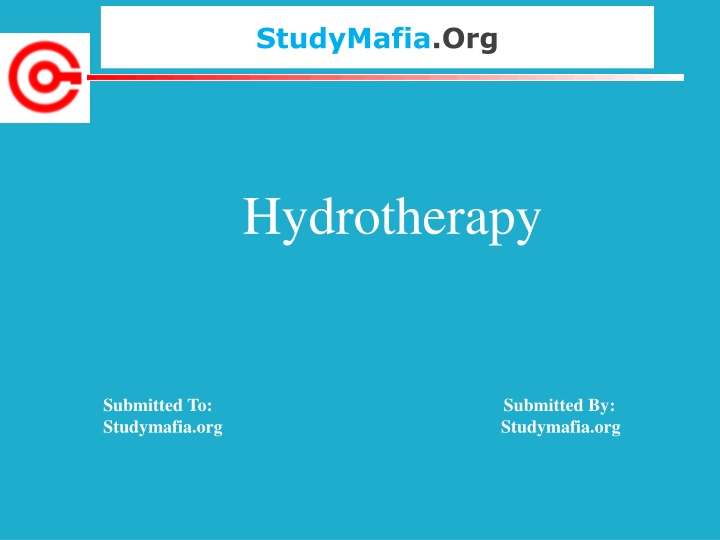Exploring the World of Hydrotherapy: Benefits, Types, and More
Hydrotherapy, using water as therapy, offers various benefits such as pain reduction, mental health improvement, and arthritis symptom relief. This form of treatment includes aquatic exercises, warm water baths, sitz baths, wraps, compresses, and saunas. Learn about the different types of hydrotherapy, how it works, potential hazards, and hydrotherapy exercises to promote relaxation and recovery. Dive into the healing properties of water therapy for a holistic approach to wellness.
Download Presentation

Please find below an Image/Link to download the presentation.
The content on the website is provided AS IS for your information and personal use only. It may not be sold, licensed, or shared on other websites without obtaining consent from the author.If you encounter any issues during the download, it is possible that the publisher has removed the file from their server.
You are allowed to download the files provided on this website for personal or commercial use, subject to the condition that they are used lawfully. All files are the property of their respective owners.
The content on the website is provided AS IS for your information and personal use only. It may not be sold, licensed, or shared on other websites without obtaining consent from the author.
E N D
Presentation Transcript
StudyMafia.Org Hydrotherapy Submitted To: Studymafia.org Studymafia.org Submitted By:
Table Contents Definition Introduction Benefits of Hydrotherapy Types of Hydrotherapy How Does Hydrotherapy works? Hazards of Hydrotherapy Hydrotherapy Exercises Conclusion 2
Definition Hydrotherapy refers to using water as therapy in any form. For instance, it may act as a treatment for temporary skin- related issues, such as burns and septic ulcers, or for chronic health conditions, such as arthritis and fibromyalgia. 3
Introduction Water therapy uses either hot or cold water, with the water pressure and flow varying among treatments. The intention is to ease both physical and mental symptoms. Some hydrotherapy practices are as simple as sitting in a warm bath, which people can do at home. Other practices involve specialist locations or equipment, such as a cold sauna. 4
Benefits of Hydrotherapy Reducing pain Improving mental health Arthritis symptoms Low impact Relaxation Recovering from workouts 5
Types of Hydrotherapy Aquatic exercise: Aquatic exercise is a low impact form of physical activity, which typically takes place in a pool using specialist equipment. It allows people to work the muscles and raise the heart rate without putting much stress on the joints. These exercise routines are suitable for people with arthritis or fibromyalgia and for older people, who may be at higher risk of falling or just find working out easier in the low impact environment. 6
Types of Hydrotherapy Warm water baths Soaking in a warm water bath is a form of hydrotherapy. The person may also add salts and minerals, essential oils, or other ingredients to enhance the bath. Sitz bath Asitz bath is a shallow bath using either warm or cold water. Practitioners may recommend sitz baths for relief from issues such as cramps or hemorrhoids. 7
Types of Hydrotherapy Wraps, compresses, and fomentation Wraps and compresses using hot, warm, or cold water are also a form of hydrotherapy. These may provide targeted relief from mild symptoms and support treatment. Saunas Depending on the definition, saunas may include both wet and dry heat saunas, as well as cool or refrigerated saunas. These involve sitting in a room set to a specific temperature with either humid or dry air. 8
Types of Hydrotherapy Water circuit therapy Water circuit therapy or contrast hydrotherapy involves going through a few different forms of hydrotherapy one after the other, generally alternating between warm and cold water to promote circulation and help ease symptoms. Immersion therapies Immersion therapies are those that involve a person immersing themselves in water for relief. 9
How Does Hydrotherapy works? Hot water is relaxing, causes blood vessels to dilate, and removes wastes from body tissues. Alternating hot can cold water also improves elimination, decreases inflammation, and stimulates circulation. Hydrotherapy involves the use of water for pain relief and treating illness. 10
Hazards of Hydrotherapy Drowning. Heat Exhaustion. Fall. Slip. Infection. Pool Entry and Egress. Skin Irritation. Droplet Infections e.g.Legionella. 11
Conclusion Hydrotherapy may have various uses as a complementary therapy to standard treatment. Relaxing hydrotherapy practices, such as saunas and foot baths, may help ease stress and allow a person to relax or alleviate painful symptoms. In each case, it is still important to work with a doctor to determine the most suitable practices for the individual. 13
References Google.com Wikipedia.org Studymafia.org Slidespanda.com
Thanks To StudyMafia.org























